

Modelling the Adjunct/Argument Distinction in Hierarchical Phrase-Based Translation Sophie Arnoult and Khalil Sima’an Institute for Logic, Language and Computation University of Amsterdam Deep Machine Translation Workshop, September 4, 2015
Introduction Labelling with Bilingual Adjunct/Argument Labels Label Clustering Conclusion The Adjunct/Argument Distinction for Hiero finally , arms fuel conflicts all over the world . A C C A A C C A enfin , les armes alimentent les conflits de par le monde . Minimally explain recursion in Hiero ▸ distinction is semantically driven ▸ adjunction is a central device for recursion The Adjunct/Argument Distinction for Hiero Sophie Arnoult and Khalil Sima’an
Introduction Labelling with Bilingual Adjunct/Argument Labels Label Clustering Conclusion Interpretation of the Adjunct/Argument Distinction A restrictive interpretation of the adjunct/argument distinction ▸ not modelling selectional preferences as in STAG ▸ adjuncts and arguments are interpreted as types in SCFG Interpretation of adjuncts ▸ adjuncts as modifiers ▸ not only in semantic frames The Adjunct/Argument Distinction for Hiero Sophie Arnoult and Khalil Sima’an
Introduction Labelling with Bilingual Adjunct/Argument Labels Label Clustering Conclusion Model ▸ Syntax-Augmented Machine Translation (SAMT) ▸ labelled Hiero model ▸ phrase labels derived from syntactic annotations through combinatory rules ▸ unlike SAMT ▸ minimal labels ▸ bilingual source/target annotations ▸ phrase-length constraint (10 tokens) ▸ no labelled reordering at sentence level The Adjunct/Argument Distinction for Hiero Sophie Arnoult and Khalil Sima’an
Introduction Labelling with Bilingual Adjunct/Argument Labels Label Clustering Conclusion Labelling procedure Procedure ▸ adjunct/argument labels ▸ combinatory rules for phrase labels ▸ (bilingual) phrase-pair labels Adjunct/Argument labels ▸ use dependency annotations ▸ map modifier and punctuation labels to adjuncts The Adjunct/Argument Distinction for Hiero Sophie Arnoult and Khalil Sima’an
Introduction Labelling with Bilingual Adjunct/Argument Labels Label Clustering Conclusion Combinatory Rules for Phrase Labels ▸ derive phrase labels from adjunct ( A ) and argument ( C ) labels ▸ SAMT-like combinatory rules ▸ extension is minimal and reflects characteristics of adjunction phrase type resulting label if constituent A or C else if constituent sequence if all adjuncts A else C S else if const. less subconstituents if all adjuncts A or C else A I or C I else P The Adjunct/Argument Distinction for Hiero Sophie Arnoult and Khalil Sima’an
Introduction Labelling with Bilingual Adjunct/Argument Labels Label Clustering Conclusion Labelled Models finally , arms fuel conflicts all over the world . A A C C I C A A I C C I A A C I P C S C I C I PC I C S C S AA A C I C I C S A A C C I C I C C I C I C I C C I A enfin , les armes alimentent les conflits de par le monde . The Adjunct/Argument Distinction for Hiero Sophie Arnoult and Khalil Sima’an
Introduction Labelling with Bilingual Adjunct/Argument Labels Label Clustering Conclusion First Results ▸ French-English Europarl ▸ in-domain LM data, dev/test sets ▸ training with 200k sentence pairs labels BLEU METEOR TER dev test dev test dev test Hiero 1 32.1 31.8 34.9 34.8 52.9 53.3 AA-Src 6 31.9 ▿▿ 31.3 ▿▿ 34.8 ▿ 34.7 ▿▿ 53.0 53.5 ▿▿ AA-Trg 6 32.0 ▿ 31.6 ▿▿ 34.9 34.7 ▿ 52.9 53.5 ▿▿ AA-Bi 36 31.9 ▿ 31.5 ▿▿ 34.8 34.7 ▿▿ 53.0 53.5 ▿ The Adjunct/Argument Distinction for Hiero Sophie Arnoult and Khalil Sima’an
Introduction Labelling with Bilingual Adjunct/Argument Labels Label Clustering Conclusion Relabelling by Clustering ▸ compare labels according to their lhs/rhs behaviour ▸ two-component distance ▸ lhs distance d LHS = Σ RHS ∣ ∆ LHS P ( rhs ∣ lhs )∣ ▸ rhs distance d cond = Σ LHS ∣ ∆ RHS P ( lhs ∣ rhs )∣ RHS d joint = Σ LHS ∣ ∆ RHS P ( lhs , rhs )∣ RHS ▸ probabilities estimated from the dev-set AA-Bi grammar ▸ clustering stops at six clusters The Adjunct/Argument Distinction for Hiero Sophie Arnoult and Khalil Sima’an
Introduction Labelling with Bilingual Adjunct/Argument Labels Label Clustering Conclusion Label Clusters d LHS + d cond d LHS + d joint RHS RHS The Adjunct/Argument Distinction for Hiero Sophie Arnoult and Khalil Sima’an
Introduction Labelling with Bilingual Adjunct/Argument Labels Label Clustering Conclusion Results with Clustered Labels (1) labels BLEU METEOR TER dev test dev test dev test AA-Bi 36 31.5 34.8 34.7 53.5 31.9 53.0 Cl-cond 6 31.8 ▾ 31.4 34.8 34.7 53.1 53.6 Cl-joint 6 31.8 ▴▴ 34.8 ▴▴ 53.3 ▴▴ 31.9 34.9 53.0 The Adjunct/Argument Distinction for Hiero Sophie Arnoult and Khalil Sima’an
Introduction Labelling with Bilingual Adjunct/Argument Labels Label Clustering Conclusion Results with Clustered Labels (2) labels BLEU METEOR TER dev test dev test dev test Hiero 1 32.1 31.8 34.9 34.8 52.9 53.3 Cl-cond 6 31.8 ▿▿ 31.4 ▿▿ 34.8 34.7 ▿ 53.1 ▿▿ 53.6 ▿▿ Cl-joint 6 31.9 ▿▿ 53.0 31.8 34.9 34.8 53.3 The Adjunct/Argument Distinction for Hiero Sophie Arnoult and Khalil Sima’an
Introduction Labelling with Bilingual Adjunct/Argument Labels Label Clustering Conclusion Future Work ▸ better method to reshape the bilingual-label set ▸ clustering works, but only allows merging ▸ lift phrase-length constraint ▸ reordering rules ▸ swap for recursion constraint ▸ extend experimental set-up ▸ other language pairs The Adjunct/Argument Distinction for Hiero Sophie Arnoult and Khalil Sima’an
Introduction Labelling with Bilingual Adjunct/Argument Labels Label Clustering Conclusion Thank you. The Adjunct/Argument Distinction for Hiero Sophie Arnoult and Khalil Sima’an
Recommend
More recommend